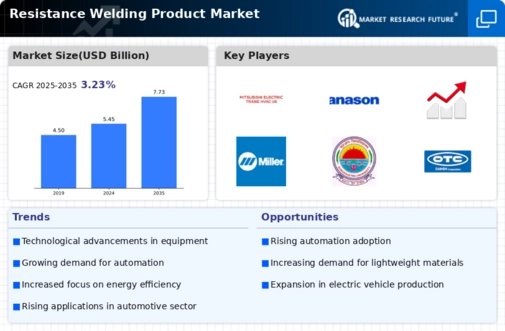Market Growth Projections
The Global Resistance Welding Product Market Industry is projected to experience substantial growth over the next decade. With a market value of 5.45 USD Billion in 2024, it is anticipated to reach 7.73 USD Billion by 2035. This growth reflects a compound annual growth rate (CAGR) of 3.23% from 2025 to 2035. The increasing demand across various sectors, including automotive, electronics, and manufacturing, is likely to drive this upward trend. As industries continue to adopt advanced welding technologies, the market is poised for significant expansion, indicating a robust future for resistance welding products.
Technological Advancements
Technological innovations play a pivotal role in shaping the Global Resistance Welding Product Market Industry. The introduction of advanced welding equipment, such as automated systems and smart welding technologies, enhances precision and reduces operational costs. These advancements enable manufacturers to achieve higher production rates while maintaining quality standards. As a result, the market is expected to grow at a CAGR of 3.23% from 2025 to 2035. The integration of artificial intelligence and machine learning in welding processes is anticipated to further optimize performance, making resistance welding more attractive to various industries beyond automotive.
Rising Focus on Energy Efficiency
Energy efficiency is becoming a critical concern across various industries, driving the Global Resistance Welding Product Market Industry. Resistance welding is recognized for its energy-saving potential compared to traditional welding methods, as it requires less energy to produce high-quality welds. This aspect aligns with global sustainability goals, prompting manufacturers to adopt more energy-efficient practices. As industries strive to reduce their carbon footprint, the demand for energy-efficient welding solutions is likely to increase. This shift not only enhances operational efficiency but also supports compliance with environmental regulations, further bolstering market growth.
Growing Demand in Automotive Sector
The automotive industry is a primary driver of the Global Resistance Welding Product Market Industry, as manufacturers increasingly rely on resistance welding for assembling vehicle components. This method offers advantages such as speed and efficiency, which are critical in meeting production demands. In 2024, the market is projected to reach 5.45 USD Billion, largely due to the rising production of electric vehicles that require advanced welding techniques. The automotive sector's shift towards lightweight materials further propels the need for resistance welding, as it provides strong joints without adding significant weight, thus enhancing vehicle performance.
Expansion of Manufacturing Facilities
The expansion of manufacturing facilities worldwide is a significant driver of the Global Resistance Welding Product Market Industry. As companies seek to enhance production capabilities and meet growing consumer demands, investments in new manufacturing plants are on the rise. This trend is particularly evident in emerging economies, where industrialization is accelerating. The establishment of new facilities often incorporates advanced resistance welding technologies, which improves production efficiency and product quality. Consequently, this expansion is expected to contribute to the overall market growth, with a notable increase in demand for resistance welding products in various sectors.
Increasing Adoption in Electronics Manufacturing
The electronics manufacturing sector is increasingly adopting resistance welding techniques, significantly influencing the Global Resistance Welding Product Market Industry. This method is particularly effective for joining thin materials used in electronic devices, ensuring reliability and durability. As consumer electronics continue to evolve, manufacturers seek efficient and cost-effective joining methods. The market's growth is supported by the rising demand for compact and lightweight electronic devices, which require precise welding solutions. This trend is expected to contribute to the market's expansion, with projections indicating a market value of 7.73 USD Billion by 2035.











